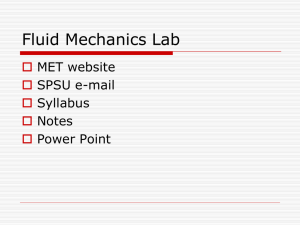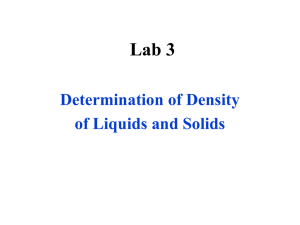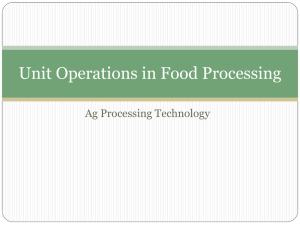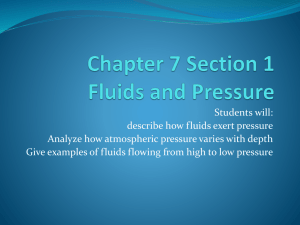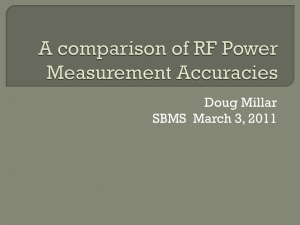Fluid Mechanics - MIT Haystack Observatory
advertisement
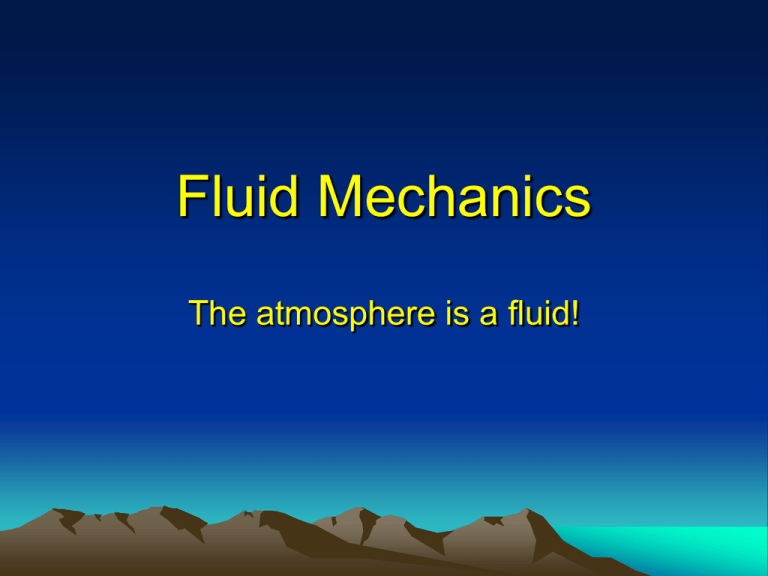
Fluid Mechanics The atmosphere is a fluid! Some definitions • A fluid is any substance which can flow – Liquids, gases, and plasmas • Fluid statics studies fluids in equilibrium – Density, pressure, buoyancy • Fluid dynamics studies fluids in motion – Extremely complex topic, just lightly covered Density • An intensive property of a substance • May vary with temperature or pressure • A homogenous material has the same density throughout • For a substance of mass m and volume V ρ = m/V where the Greek letter ρ (rho) is density Atmospheric Density • Because the atmosphere is a gas, and gases are compressible, density will vary with height • The atmosphere will be more dense at the surface and less dense as altitude increases ρair = 1.20 kg/m3 @ 1 atm and 20 ºC Pressure in a fluid • Pressure is the ratio of the perpendicular force applied to an object and the surface area to which the force was applied P = F/A • Don’t confuse pressure (a scalar) with force (a vector). The Pascal • The SI unit of pressure is the pascal (Pa) 1 Pa = 1 N/m2 named after Blaise Pascal (1623-1662). One pascal also equals 0.01 millibar or 0.00001 bar. • Meteorologists have used the millibar as a unit of air pressure since 1929. Millibar or hPa? • When the change to scientific units occurred in the 1960's many meteorologists preferred to keep using the magnitude they were used to and use a prefix "hecto" (h), meaning 100. • Therefore, 1 hectopascal (hPa) = 100 Pa = 1 millibar (mb). 100,000 Pa equals 1000 hPa which equals 1000 mb. The units we refer to in meteorology may be different, however, their numerical value remains the same. Atmospheric Pressure • We live at the bottom of a sea of air. The pressure varies with temperature, altitude, and other weather conditions • The average at sea level is 1 atm (atmosphere) • Some common units used: 1 atm = 101,325 Pa 1 atm = 1013.25 mb = 1013.25 hPa 1 atm = 760 mmHg = 29.96 inHg 1 atm = 14.7 lb/in2 Atmospheric Layer Boundaries • The layers of our atmosphere can vary in thickness from the equator to the poles • The layer boundaries occur at changes in temperature profile Image courtesy NASA Temperature affects pressure • When air warms, it expands, becoming less dense. Lower density means a volume of air weighs less, therefore applying less pressure. ← Approx 5.6 km Image Courtesy NOAA Fluid Pressure • A column of fluid h = 4 m high will exert a greater pressure than a column h = 2 m • What will the pressure be due to this fluid? Force = mg Area = A But m = ρV and A = V/h Pfluid = ρVg/V/h = ρgh Assuming uniform density for the fluid Pfluid = ρgh • The pressure due to a fluid depends only on the average density and the height • It does not depend on the shape of the container! • The total pressure at the bottom of an open container will be the sum of this fluid pressure and the atmospheric pressure above P = P0 + Pfluid = P0 + ρgh Compressibility • Liquids are nearly incompressible, so they exhibit nearly uniform density over a wide range of heights (ρ only varies by a few percent) • Gases, on the other hand, are highly compressible, and exhibit significant change in density over height ρair at sea level ~ 3ρair at Mt Everest’s peak Pascal’s Law • Pressure applied to a contained fluid is transmitted undiminished to the entire fluid and to the walls of the container • You use this principle to get toothpaste out of the tube (squeezing anywhere will transmit the pressure throughout the tube) • Your mechanic uses this principle to raise your car with a hydraulic lift Absolute and Gauge Pressure • Your tire maker recommends filling your tires to 30 psi. This is in addition to the atmospheric pressure of 14.7 psi (typical) • Since P = P0 + Pfluid, the absolute pressure is P, and the gauge pressure is Pfluid • In this case, the gauge pressure would be 30 psi and the absolute pressure would be 44.7 psi (psi = pounds per square inch) Measuring Pressure • There are two main types of instruments used to measure fluid pressure • The Manometer – Blood pressure is measured with a variant called the sphygmomanometer (say that three times fast!) • The Barometer – Many forms exist The Manometer • Open-tube manometer has a known pressure P0 enclosed on one end and open at the other end P0 - Pa = ρgh • If Pa > P0, the fluid will be forced toward the closed end (h is neg, as shown) Image from Ruben Castelnuovo - Wikipedia The Barometer • Filling a tube (closed at one end) with liquid, then inverting it in a dish of that liquid • A near vacuum will form at the top • Since Pfluid = ρgh, the column of liquid will be in equilibrium when Pfluid = Pair • Meteorologist speak of 29.96 inches. This is the height of a column of Mercury which could be supported by that air pressure Superman and the straw • Could Superman sit at the top of the Empire State Building and sip a beverage at the ground floor through a long straw? • No! It is the air pressure on the top of the beverage which pushes the liquid up through the straw, regardless of what you do at the other end Max height at 1 atm = ρgh = 10.34 m assuming ρwater = 1000 kg/m3 and g = 9.8 m/s2 How do they get water up there? • You can’t leave it to atmospheric pressure to raise water above ~ 34 feet (10.34 m), so how do they get water to the top of the Empire State Building (381 m)? • You must have a closed system (water pipes), then use Pascal’s Law to apply pressure evenly throughout the pipes Buoyancy • Archimedes’s principle states that the buoyant force on an object immersed in a fluid is equal to the weight of the fluid displaced by that object Volume of object = VO Weight of fluid = mFg mF = ρFVO FB = ρFVOg Lighter than air? • The atmosphere is a fluid • Scientific instruments are carried into the atmosphere by balloons filled with helium • At some point, ρair = ρballoon and the balloon will stop rising (FB up = FG down) • This is why there is little in situ scientific data regarding the Mesosphere – it is above the height of a balloon’s buoyancy, but still too much air for satellite orbits (meteors burn up here!) Fluid Dynamics • Just as there is a concept of an ideal gas, there is a notion of an ideal fluid – Not compressible – No internal friction (viscosity) • Liquids approximate ideal fluids • Gases are close to ideal only if the pressure differences from one area to another are small Fluid Flow • Fluid flow can be – Laminar (smooth, sheet-like) – Turbulent (chaotic, eddy circulation) • A streamline is a curve which traces the fluid flow (points are tangent to velocity) • For an Airfoil and Curveball simulator, go to the NASA site http://www.grc.nasa.gov/WWW/K12/FoilSim/index.html Continuity Equation • Given an ideal fluid (non-compressible) in a pipeline or other conduit (no sources or sinks), whatever flows in must flow out • This is a statement of conservation of mass – whatever flows across one boundary must arrive at the next boundary ρA1v1Δt = ρA2v2 Δt A1v1 = A2v2 Pressure in a moving fluid • As shown by the continuity equation, the speed of flow may vary along a given path • We can derive the Bernoulli equation which relates pressure, flow speed, and height for an ideal fluid • The derivation is complex, involving the application of the work-energy principle and conservation of energy Bernoulli’s equation • The result is Bernoulli’s equation: P1 + ρgy1 + 1/2 ρv12 = P2 + ρgy2 + 1/2 ρv22 • The subscripts refer to any two points along the fluid • At rest (v1 = v2 = 0), this reduces to the static equation • This is ONLY valid for ideal fluids! Fluid speed and pressure • The result: in a pipe of varying diameter, the fluid will always flow faster in the narrower pipe • The pressure will be smaller when the flow is faster Fluid Resistance and Drag • At low speed, fluid resistance is proportional to velocity F = kv • At higher speeds, air drag is proportional to the square of velocity F = Dv2 • Where k and D are constants of proportionality which depend on the size and shape of the object and the properties of the fluid • Can’t use kinematic equations with constant aceleration to solve for motion!

